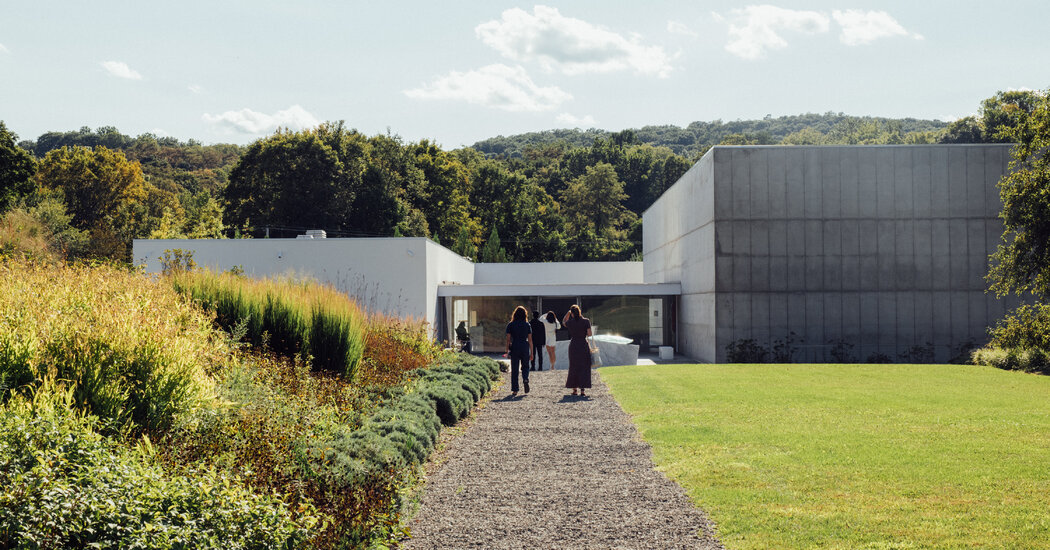
On a breezy Saturday last month, Vittorio Calabrese, the director of the Magazzino Italian Art museum in Cold Spring, N.Y., stood onstage in the courtyard to introduce the last event of the summer, a concert by the musician Sam Reider and his band the Human Hands.
The sun was starting to set, and a few stragglers of the sold-out crowd found their seats. Most of the concertgoers were dressed casually in denim jackets and oversize oxford shirts. But Mr. Calabrese, a native of Irpinia, Italy, wore a blue suit, loafers and, for a touch of sprezzatura, the Italian concept of nonchalant style, striped socks with several inches visible. Mr. Reider, he said, was going to play a song inspired by Ennio Morricone in the tradition of the American murder ballad.
It wasn’t exactly “Volare,” but that has never been the point of the foundation. “The biggest challenge is to avoid stereotypes of Italy,” Mr. Calabrese said. “People think they will find Renaissance or Baroque or ancient art, but we are not — and Italy is not — what the average American would think it is. Most of this art was unknown in this country.”
The foundation, which is about an hour’s drive north of Manhattan, is dedicated to Italian art of the postwar period, beginning with the Arte Povera movement that began in Turin in the 1960s and continuing with contemporary artists.
“We don’t have paintings, and we don’t have figuration,” said Mr. Calabrese, who lives in Beacon, N.Y., and the Fort Greene section of Brooklyn.
Instead, visitors will find “Altri Venti-Ostro,” by Bruna Esposito, a piece about air conditioning and city living in the form of an outdoor gazebo made of bamboo canes and hemp rope and boat propellers. Giulio Paolini’s “Il cielo e dintorni” consists of 18 white flags printed with depictions of the sky, as imagined by artists working from the Renaissance to today, including Yves Klein, J.M.W. Turner and Raphael. There is a giant glass thumbnail by Giuseppe Penone.
Magazzino was conceived and founded by Giorgio Spanu, an investor who grew up in Sardinia, and Nancy Olnick, who comes from a real-estate developing family in Manhattan.
“On our third date he invited me to his house for dinner,” Ms. Olnick said. “I bring this wine, and he goes, ‘Where’d you find this wine?’” She wore nearly identical tiny round glasses as her husband, and as she spoke, he pulled out “La Muséologie Selon Georges Henri Rivière,” a book by a French museologist. “And he proceeded to prepare this meal that was exquisite — the wine, the meal and the discussion,” Ms. Olnick said.
Together they collected enough Italian art to fill a private museum. Magazzino opened in June 2017 with a show of Margherita Stein’s contributions to Arte Povera. During the pandemic, their at-home programming included a streamed discussion “BLAQ•IT: Representing Blackness in Italy” with the scholar Fred Kuwornu.
Before the concert there was aperitivo hour, as one does in Italy. “We are finding ways to engage with artists beyond visual arts,” said Mr. Spanu, as he surveyed the spread of tomato jam and flatbread and goat cheese tarts and tall glasses of various spritzes.
The first clue that Magazzino, which means warehouse in Italian, is not a place where visitors will find Da Vincis may be the building itself: a 20,000-square-foot concrete Brutalist space designed by the Spanish architect Miguel Quismondo with eight galleries, a courtyard for concerts and movie screenings, and a research center.
It is also home to 16 miniature Sardinian donkeys that serve as a kind of mascot, most with Italian names that begin with “D” for donkey: Dino, Donatella. Mr. Calabrese noted that the donkeys are the best way to get children on a museum visit to behave. The donkeys enjoy an exalted existence, nuzzling with each other, getting cooed at by visitors and eating hay from a sculpture by Namsal Siedlecki called “Trevis Maponos,” forged from coins tossed into the Trevi Fountain in Rome.
Still, Mr. Calabrese wanted Magazzino to be seen as more than just striking architecture and friendly donkeys. “Our big challenge,” he said, “is changing the image of Italy.”
As the band played modern folk songs, accompanied by saxophones and accordions, the setting sun bounced sharp angles on the concrete walls. Ms. Olnick, Mr. Spanu and Mr. Calabrese sat in the front row, rapt.
Even though the foundation has been open for four years (minus a pandemic lockdown), it seems as if its reputation as a chic day trip from the city (it offers a free shuttle from the Cold Spring train station) was just starting to coalesce.
Soon they will break ground on a new pavilion with room for another gallery and a cafe. Magazzino is surrounded by orchards with lemons and apples and a mix of Mediterranean and local flora.
“People request to get married here once every week,” Mr. Calabrese said.






